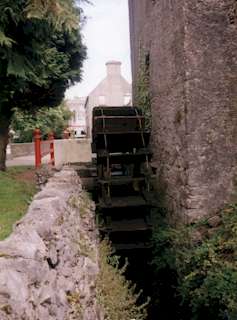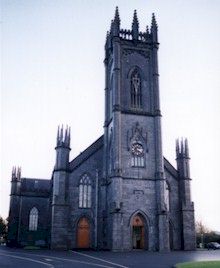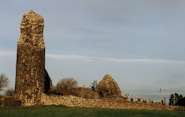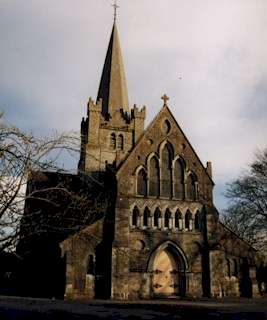|
Visiting hours at St. Marys Cathedral
From Friday April 20th to Friday 7th September 2012.
Fridays only from 10.30 a.m. to 1.00 p.m. and from 2.00 p.m. to 5.00 p.m.
Any other time is by prior appointment. One days notice is required.
Call Jarlath on 087 4121201 to arrange.

Local
Attractions in and about Tuam
Tourism in Tuam had
very small beginnings. It started with the establishment of the
Mill Museum which was opened to the public in
1974. This old mill
is now the only water powered preserved corn mill in the West of
Ireland which is still operated as a voluntary community project.
Since 1983 a seasonal tourist
information office is operated from the Mill Museum.
In addition, the Mill Museum
operates walking tours of the Town for visiting groups and covers all the
historical aspects of the Town. These tours start at Abbeytrinity Car
Park. This car park takes its name from the Premonstratention abbey which
was established in Tuam during the latter part of the 12th century. From
this car park the visitors are brought through the Town, stopping at
interesting points along the way, the first stop being The Chair of Tuam,
then on to the largest house in the Town which at one time was the
residence of the Church of Ireland Archbishops and later Bishops of Tuam.
The building was vacated in the early 1950's and was for a time used a
sleeping quarters for the boarders at Presentation College, Currylea until the boarders were phased out in the early 1990's. It was then taken
over by a local Supermarket owner, beautifully restored and now has a
restaurant on the ground floor known as The Palace Restaurant. This house
was built between 1716 and 1741 by Archbishop Edward Synge as is still the
largest house in the Town.
The Community Centre, which
is adjacent to the Palace was at one time the stables and servants
quarters. The building now serves as the local community centre and also
houses a number of community and private business projects.
 As
visitors walk towards the Roman Catholic Cathedral they will notice that
on either side of the Cathedral there are a number of schools.
St. Jarlath's College (est.1800), Presentation Convent (est. 1835),
Sisters of Mercy Convent (est. 1846) and St. Patrick's College (est. 1851
by the Irish Christian Brothers). In addition, there is another school,
the John MacHale vocational school ( est. 1937). As
visitors walk towards the Roman Catholic Cathedral they will notice that
on either side of the Cathedral there are a number of schools.
St. Jarlath's College (est.1800), Presentation Convent (est. 1835),
Sisters of Mercy Convent (est. 1846) and St. Patrick's College (est. 1851
by the Irish Christian Brothers). In addition, there is another school,
the John MacHale vocational school ( est. 1937).
The Catholic Cathedral was
built between 1827 and 1836 during a famine period in parts of the West of
Ireland. The building of the Cathedral was commenced by Archbishop Oliver
Kelly, Archbishop of Tuam 1815 to 1834 and it was completed By Archbishop
Oliver MacHale, Archbishop of Tuam 1834 to 1881. There are many
interesting facets to this limestone building, the classic faces around
the windows the humorous faces at the rear of the Cathedral and the stain
glass windows by The Harry Clarke studios which date from the early 20th
century.
The Town centre, which was
laid out in the early 17th century following the granting of a royal
charter by King James the first of England has the Town Hall as its centre
piece. This building was originally built in 1853 and is currently being
modernised. Opposite the Town Hall is The Imperial Hotel which has served
as a hotel in Tuam since the 19th century.
 Temple Jarlath (The place of
Jarlath) is the next stop for visitors and here we can see the remnants of
the earliest monastic settlement which established Tuam as a population
centre. Temple Jarlath (The place of
Jarlath) is the next stop for visitors and here we can see the remnants of
the earliest monastic settlement which established Tuam as a population
centre.
Tradition has it that Jarlath
was a member of a large religious community at Cloonfush and Kilbannon
which are areas a few miles outside the Town. In time, Jarlath's life
became uncertain as he wished to travel and establish his own monastery.
Eventually his abbot St. Benin bade him "Go, and where ever your
chariot wheel breaks, there shall be the site of your new monastery and
the place of your resurrection". So it was that Jarlath's wheel broke
in the area that is now called Temple Jarlath.
This was the first Christian
settlement in Tuam and supplanted the old pagan burial beliefs with
Christian values and beliefs as taught by St. Patrick.
 The
next stop for visitors is St. Mary's Cathedral. The
next stop for visitors is St. Mary's Cathedral.
The first Cathedral on this
site dates from the 12th century when Turlough O’Conor was High
King of Ireland (1111-1156). This marked the establishment of Tuam as the
seat of an Archbishop following the Synod of Kells in 1152. This first
Cathedral was destroyed by fire in 1184 and the site was abandoned for
almost 100 years. In the 14th Century a 2nd
Cathedral was built by the DeBurgo family but only what is referred to as
the Synod Hall was ever completed. This was due to a money shortage
because of the 100 years war in Europe. The 12th century
Chancel and sanctuary of the first Cathedral was incorporated into the 2nd
Cathedral and was used as the entrance to what was still a Catholic
Cathedral. With the onset of the reformation in the 16th
Century the Cathedral was taken over by the reformed Church when William
Mullaly was appointed as the 1st Protestant Archbishop of Tuam
in 1573. With the coming of the railway to Tuam in 1860, and the
enlargement of the army garrison, the local Anglican population increased
to such an extent that the 14th Century Cathedral was no longer
large enough to accommodate the congregation and this led to the building
of a 3rd Cathedral on this site, designed by Sir Thomas
Newenham Deane which was built between 1861 and 1878. This 3rd
Cathedral was built on the site of the 1st Cathedral and
incorporated the 12th Century Hiberno-Romanesque arch as the
sanctuary while the 2nd Cathedral became the synod hall which
was restored between 1985-1987 and made available for community use. This
3rd Cathedral is still used today for Sunday Services which
take place at 12.00 Noon.
This
Cathedral contains relics of the Town’s past glories, the High Cross which
is classed as a National Monument, was removed from The Town Centre in
1992 and erected in the south transept of this Cathedral in June of that
year. In the North Transept, the ornamental shaft of another cross which
also dates from the 12th Century survives.
A
number of stained glass windows depict the faces of former parishioners.
The West window of the Cathedral depicts the Transfiguration of Our Lord
and is seen at its best when the sun is beginning to set during the summer
months. Underneath this window are seven small lancet windows referred to
as lights. The centre panel depicts Christ The King and is erected to the
memory of Sir Thomas Deane, architect of the 3rd Cathedral. The
other windows depict Prophets of the Old Testament beginning from the left
with Moses, David, Solomon, Ezra, Malachi and John The Baptist.
The last stop on the walking
tour of the Town is a visit to The Mill Museum with its still working
water wheel and machinery still intact. The Museum was established as a
voluntary community project in 1974 and still coninues as such. It is the
only preserved working corn mill in the West of Ireland and its history
dates back the the late 17th century.
Clais an Aifrinn
During the penal laws Mass was not publicly celebrated in Tuam .In Sylane,
near Tuam there is an open pit called Clais an Aifrinn in
which an altar and cross is erected to commemorate the time when Fr Ulick
Nally,
P.P Cummer celebrated Mass there for his people.
Ballytrasna /
Gardenfield Golden Mile
The
residents of Ballytrasna / Gardenfield are in possession of one of the
most beautiful miles’ in the whole County. The village is located
just 2 miles north of Tuam, just off the main N17 road and visitors
are always welcome to stroll along our mile. Here you will find many
places of interest including ringforts, the famous “Lally’s
monument”, a natural bird sanctuary, a mass path, a lost village,
the Holy Year Cross, an old village pump, many groves of trees that
came from the 4 corners of the globe, a large Turlough, two National
Schools (old & new) and much more.
-
Mill
Museum an audio visual museum
containing a restored corn mill with operating water wheel.
-
Chair
of Tuam part of the O’Connor castle, located in
O’Tooles car park.
-
Teampall
Jarlath 13th century parish
church ruins and graveyard.
-
Palace
Grounds a beautiful maintained scenic
park with picnic area and 2km walkway through the trees.
-
St.
Mary’s Cathedral and Synod Hall incorporating
the chancel and Hiberno-Romanesque arch of a former Cathedral.
Location : High St.
-
Cathedral
of the Assumption the
location at which St Jarlath's chariot wheel came undone.
-
Cloonfush
Graveyard reputed to be the starting point of St
Jarlath’s journey. Directions – from town centre, 1km towards
Galway, first turn right, 2km to end of road.
-
Clais
an Aifrinn , where Mass was celebrated in Penal Times.
Directions – from town centre, .5km towards Galway, first turn right
at lights, 2km to Sylane.
-
Castlehackett
reputed to be the burial spot of Queen Maeve.
Directions – from town centre, 2km towards Galway, 2nd turn
right, sign posted for Belclare 1km in that road.
Nearby Attractions
Attraction within
driven distance include :
-
Croagh
Patrick
-
Knock
-
Connemara
-
The
Shannon
-
The
Burren
Local
Golf Clubs
Tuam
Golf Club - Website
Athenry Golf Club |



